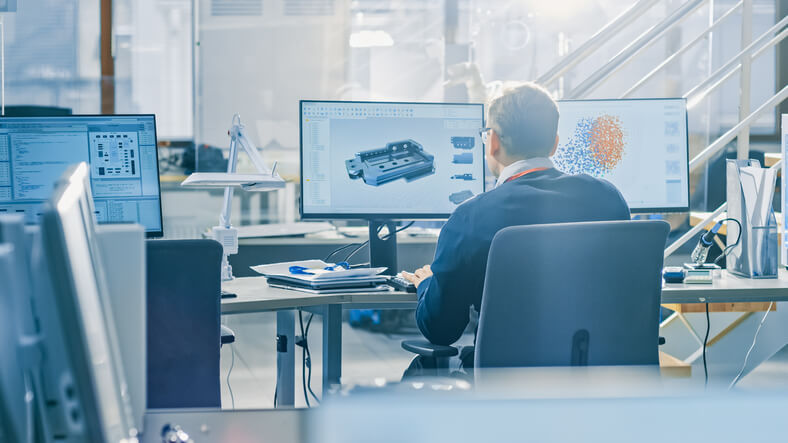Organizing and Presenting Data is More Critical Than Ever for Manufacturers
The feeding system industry encompasses more than the machinery needed to ensure automation solutions continue to supply a steady rate of parts into manufacturing and production processes. Technological advancements in areas such as vision systems and robotic picking cells, the continued integration of IT and Operational Technology, and the onset of Industry 4.0 all impact automation and part feeding as well.
Another technology, 3D modeling, has also become a factor and differentiator in the feeding system industry. The use of this tech allows manufacturers to design parts more quickly and creatively, helps market and communicate information about solutions more effectively and has become instrumental in devising and shaping the production plant layouts of today and in the future.
What is 3D Modeling?
Put simply, this process creates 3D images of items — be it an individual part, a piece of automation machinery, or an entire factory — using computer software. Using points in virtual space known as vertices to form a virtual mesh model, 3D designers can create virtual representations of nearly anything. This ability to provide greater visualization for components that can be difficult to understand or organize in abstract form provides a strong value for manufacturers and the feeding system industry.
Get Started with Feedall: We welcome you to fill in our online RFQ with your equipment preferences, tooling requirements, and applicable options. We’ll get back to you in hours.
Get a Clearer, More Vibrant View of the Feeding System Industry
3D modeling brings a variety of advantages when compared to traditional 2D drawings or representations of designs or layouts. Certainly, 2D modeling can provide a high level of detail, but the information — as presented in that format — can be dense and hard to interpret.
The ease of deciphering and integrating information from a 3D model, compared to a 2D equivalent, is one reason why many companies in the feeding system industry have gravitated toward incorporating those three-dimensional representations more and more. For example, the use of 3D rendering has been a boon for marketing and communication efforts. Whether it’s for product promotion, advertising, or an official company proposal, 3D models add clarity and impact and many manufacturing companies have already started to benefit from these characteristics.
3D modeling also enables:
- High-quality prototyping
- A less expensive option to professional photography
- A complete display of a model’s physical footprint
- Easier documentation and record-keeping
These benefits are all a part of one of the most valuable uses for 3D modeling, virtual plant layouts.
Plant Layouts
A plant layout is the physical arrangement of production, administration, utility, storage, and transportation equipment, raw materials, labor, and services facilities used in a factory to manufacture parts and products. Traditionally, these production blueprints were communicated through 2D drawings. This presented challenges, however. Imagine an assembly table on a factory floor. This could be shown by a simple rectangle in a 2D system. But with a 3D model, other important details such as the supporting frame, the table height, a footrest, etc., can also be shown.
Using 2D drawings to design comprehensive plant layouts can make it hard to position machinery accurately, visualize the space needed to safely operate and maintain equipment, and communicate important operational information to non-technical stakeholders. 3D plant and process design software help avoid production delays and budget overruns due to unforeseen conflicts in spacing or failing to account for vertical details.
3D allows for a user-friendly, fast, and efficient layout definition. Standard resources, like conveyors and shelving, can be factored into the overall layout. Because the information is digital, simulations can be run with the data analyzed to adjust the entire process plan, layout and factory flow.
Feedall is Embracing the Future
As a premier automation company, Feedall has always invested in technology to stay abreast of new trends in the feeding system industry. We take pride in supporting our customers as new demands and requirements arise.
Feedall is at the forefront of supporting 3D modeling efforts with our designs and production materials. We accommodate requests for 3D models and make them available so our manufacturing partners can make better decisions about how our automation machinery and devices will fit into their overall production layout. Feedall uses SOLIDWORKS, a solid modeling computer-aided design (CAD) and computer-aided engineering (CAE) tool, to offer these capabilities.
You can view some examples of our 3D modeling of specific part feeders here:
This is a still emerging and developing technology. As manufacturing continues to make 3D modeling, and other feeding system industry trends, the standard, Feedall will continue to develop our capabilities to support their goals.
Get a Different Perspective: Our Helpful Videos page allows you to see many of our part-feeding devices in action and get a feel for their capabilities. Check them out here.
Feedall is Your Feeding System Industry Expert
Feedall Automation has more than 75 years of success in delivering industrial automation solutions in multiple markets and supports your business goals of more efficiency, increased output, and lower operating costs.
When you partner with Feedall, you’re collaborating with an automation expert that delivers proven part-feeding and industrial automation solutions that can be integrated seamlessly into your production line. We understand the importance of keeping up to date on the feeding system industry and make every effort to reach and exceed our customers’ needs when it comes to new aspects — such as 3D modeling.
Feedall presents the details about your project in the format or layout most suitable to your organization so you can properly plan and execute your production line. Also, every device and piece of equipment we provide is backed with parts availability, support services, and a best-in-class repair program, ensuring your investment remains viable and productive for the long term.
